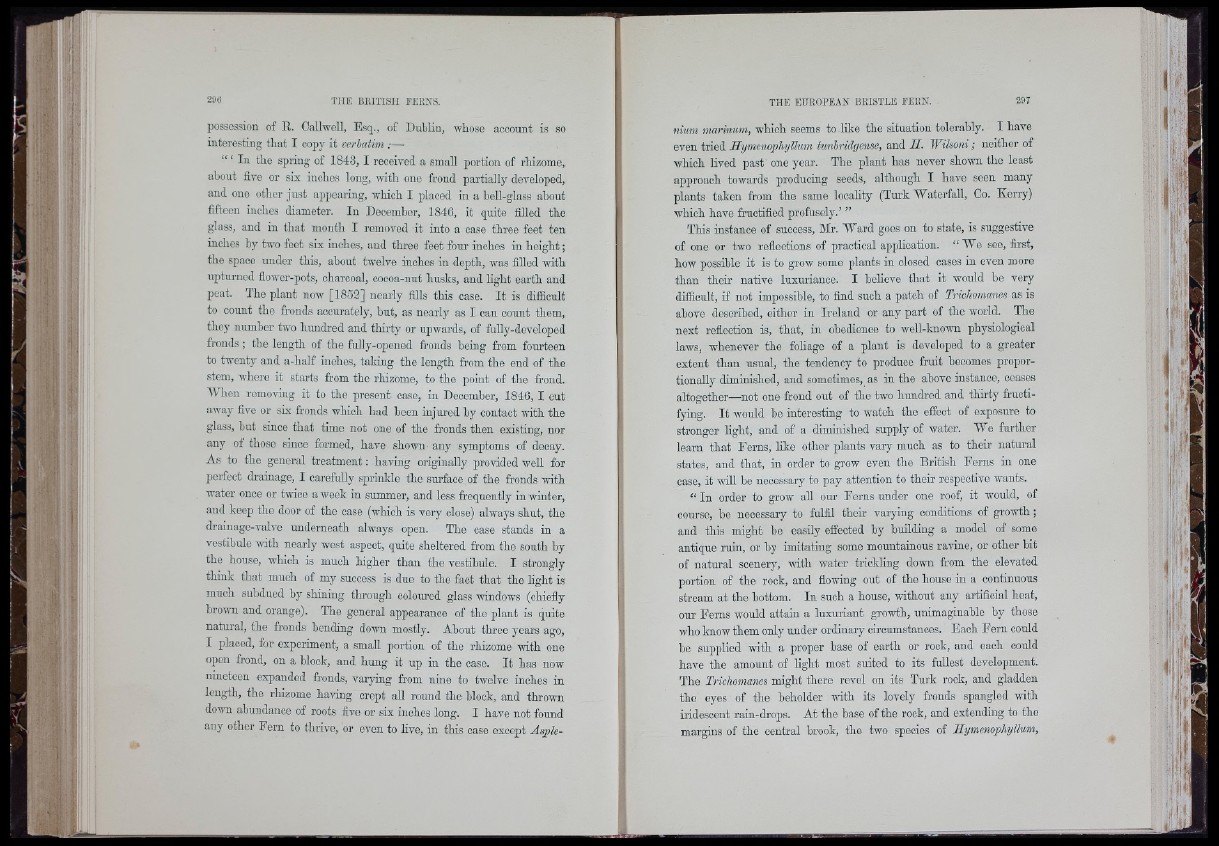
1
I
possession of R. Callwell, Esq., of Dublin, whose account is so
iuterosting that I copy it verbatim :—
“ ‘ In the spring of 1843, I received a small portion of rhizome,
about five or six inches long, with one frond partially developed,
and one other just appearing, which I placed in a bell-glass about
fifteen inches diameter. In December, 1846, it quite filled the
glass, and in that month I removed it into a case three feet ten
inches hy two feot six inches, and three feet four inches in height;
the space under this, about twelve inches in depth, was filled with
upturned flowcr-pots, charcoal, cocoa-nut husks, and light earth and
peat. The plant now [1852] nearly fills this case. It is difficult
to count tho fronds accurately, hut, as nearly as I can count them,
they number two hundred and thirty or upwards, of fuUy-developod
fronds; the length of the fully-opened fronds heing from fourteen
to twenty and a-half inches, taking the length from the end of the
stem, where it starts from the rhizome, to the point of the frond.
When removing it to the present case, in December, 1846, I cut
away five or six fronds which had been injured hy contact with the
glass, but since that time not one of the fronds then existing, nor
any of those since formed, have shown any symptoms of decay.
As to the general treatment: having originally provided well for
perfect drainage, I carefully sprinkle the surface of the fronds with
water onoe or twice a week in summer, and less frequently in winter,
and keep the door of the case (which is very close) always shut, the
drainage-valve underneath always open. The case stands in a
vestibule xrith nearly west aspect, quite sheltered from the south by
the house, which is much higher than the vestibule. I strongly
think that much of my success is due to the fact that the light is
much subdued by shining through coloured glass windows (chiefly
brown and orange). The general appearance of the plant is quite
natural, the fronds bending down mostly. About three years ago,
I placed, for experiment, a small portion of the rhizome with one
open frond, on a block, and hung it up in the case. It has now
nineteen expanded fronds, varying from nine to twelve inches in
length, the rhizome having crept all round the block, and thrown
doTO abundance of roots five or six inches long. I have not found
any other Eern to thrive, or even to live, in this case except Asplenium
marinum, which seems to like the situation tolerably. I have
even tried IlymenophyUum tunbridgense, and II. Wilsoni; neither of
which lived past one year. The plant has never shown the least
approach towards producing seeds, although I have seen many
plants taken from the same locality (Turk Waterfall, Co. Kerry)
which have fructified profusely.’ ”
This instance of success, Mr. Ward goes on to state, is suggestive
of one or two reflections of practical application. “ We see, first,
how possible it is to grow some plants in closed cases in even more
than their native luxuriance. I believe that it would bo very
difficult, if not impossible, to find such a patch of Trichomanes as is
above described, either in Ireland or any part of the world. The
next reflection is, that, in obedience to well-known physiological
laws, whenever tho foliage of a plant is developed to a greater
extent than usual, the tendency to produce fruit becomes proportionally
diminished, and sometimes, as in the above instance, ceases
altogether—not one frond out of the two hundred and thirty fructifying.
It would be interesting to watch the effect of exposure to
stronger light, and of a diminished supply of water. We further
learn that Ferns, hke other plants vary much as to thoir natural
states, aud that, in order to grow even the British Ferns in one
case, it will be necessary to pay attention to their respective wants.
“ In order to grow all our Ferns under one roof, it would, of
course, be necessary to fulfil their varying conditions of growth;
and this might bo easily effected hy building a model of some
antique ruin, or by imitating some mountainous ravine, or other bit
of natural scenery, with water trickling down from the elevated
portion of the rock, and flowing out of the house in a continuous
stream at the bottom. In such a house, without any artificial heat,
our Ferns would attain a luxuriant growth, unimaginable by those
who know them only under ordinary circumstances. Each Fern could
be supplied with a proper base of earth or rook, and each could
have the amount of light most suited to its fullest development.
The Trichomanes might there revel on its Turk rook, and gladden
the eyes of the beholder with its lovely fronds spangled with
iridescent rain-drops. At the base of the rook, and extending to the
margins of the central brook, the two species of Hymenophyllum,
i t t l
/■Mil
I i
■I : ,
iflll
H i